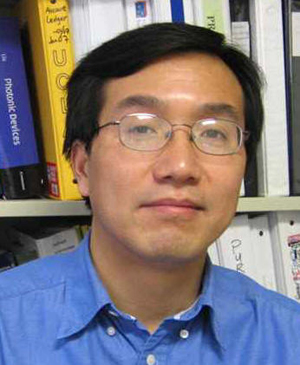Qibing Pei Develops Fully Stretchable OLED
Qibing Pei has led a UCLA team in developing the first fully stretchable organic light-emitting diode (OLED). This represents a major advance over earlier LEDs that can only bend without stretching or that stretch by merely connecting smaller LED segments.
Pei’s team team coated carbon nanotubes onto a glass backing and added a liquid polymer that diffuses throughout the nanotube network and dries to a flexible plastic that completely surrounds the network. The polymer-nanotube layer was peeled off of the glass to yield a smooth, stretchable, transparent electrode.
The team sandwiched two layers of the carbon nanotube electrode around a plastic that emits light when a current runs through it. It used an office laminating device to press the final, layered device together tightly to ensure that the circuit would be complete when electricity was applied. The resulting OLED can be stretched by as much as 45 percent while emitting a colored light.
“The infusion of the polymer into the carbon nanotube coatings preserved the original network and its high conductance,” Pei told Technology Review.
“The approach we used is very simple and can be easily scaled up for real production,” said Zhibin Yu, a researcher formerly in Pei’s group and currently at the UC Berkeley. Yu had initially author the paper on the development which was published online last month in Advanced Materials.
“The fact that the fabricated OLED can work under stretched conditions is quite impressive,” says Jay Guo, a professor of electrical engineering at the University of Michigan who works on manufacturing plastic electronics.
Pei’s proof-of-concept device is a two-centimeter square with a one-centimeter square area that emits a sky-blue light. This week the team published a second paper showing that swapping in more-conductive silver nanowires for carbon nanotubes in a similar process made a more efficient light-emitting diode.
Stretchable OLEDs would allow manufacture of video displays that could be rolled up or cell phones that could expand from a more compact form factor. They could also be cut like fabric to form the skin of robots or embedded medical devices.
Since July 2004 Qibing Pei has been a professor of materials science and engineering at UCLA where he specializes in synthetic polymers. He has worked as a senior chemist at UNIAX Corporation in Santa Barbara, CA (later merged into DuPont Display). Prior to that he worked as a senior chemist at Imation Corporation in Santa Paul, MN and a senior research engineer at SRI International in Menlo Park, CA. Pei received his Ph.D. in polymer science from the Chinese Academy of Sciences in Beijing.
Pei has developed electronic and electroactive polymers for applications in electro-optic and electro-mechanical devices, including light emitting diodes, polymer light emitting electrochemical cells, electroactive polymer artificial muscles, and biologically-inspired robots. His research interests span from material synthesis, processing, to design of functional devices. He applies organic synthesis, polymer synthesis, solution-based processing and nanofabrication in the discovery of new polymers and multifunctional composites.

Qibing Pei led a UCLA team that developed the first truly stretchable OLED.

